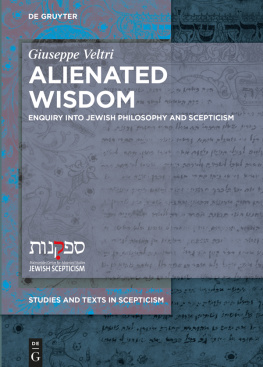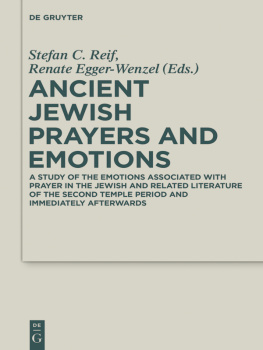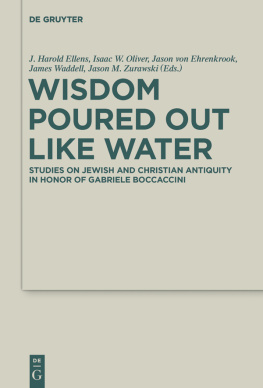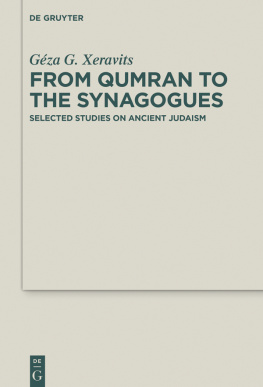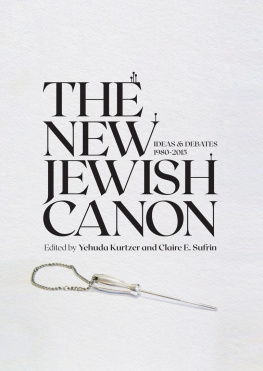Contents
Guide

Second Temple Jewish Paideia in Context
Beihefte zur Zeitschrift fr die neutestamentliche Wissenschaft
Edited by
Carl R. Holladay, Matthias Konradt,
Hermann Lichtenberger, Judith Lieu,
Jens Schrter and Gregory E. Sterling
Volume 228

ISBN 978-3-11-054606-4
e-ISBN (PDF) 978-3-11-054697-2
e-ISBN (EPUB) 978-3-11-054611-8
ISSN 0171-6441
Library of Congress Cataloging-in-Publication Data
A CIP catalog record for this book has been applied for at the Library of Congress.
Bibliografische Information der Deutschen Nationalbibliothek
Die Deutsche Nationalbibliothek verzeichnet diese Publikation in der Deutschen Nationalbibliografie; detaillierte bibliografische Daten sind im Internet ber http://dnb.dnb.de abrufbar.
2017 Walter de Gruyter GmbH, Berlin/Boston
www.degruyter.com
Jason M. Zurawski and Gabriele Boccaccini
Introduction: Perspectives on Second Temple Jewish Paideia from the Fifth Nangeroni Meeting
Despite the incredible strides made in the past century in the understanding of Second Temple Judaism and the strong scholarly interest in Greek and Christian paideia and their relationship following the work of Werner Jaeger, This led to several anachronistic presuppositions, such as the common claim of a universal school system throughout Hellenistic and Roman Judea.
It is within this context that the Fifth Nangeroni Meeting gathered from June 30 to July 4, 2015 in Naples, Italy, at the invitation of the Enoch Seminar and the University of Naples Federico II, and with the support of the FIRB research project under the direction of Luca Arcari: The Construction of Space and Time in the Transmission of Collective Identities. Religious Cohabitations and/or Polarizations in the Ancient World (1st6th cent. CE). The meeting was made up of eight major paper sessions, each of which featured a brief introduction by the author, a ten-minute response, and seventy minutes of moderated discussion. There were also three short paper sessions. All sessions were held at the University of Naples Federico II with the exception of the closing session on Saturday, which took place in the thirteenth-century castle Maschio Angioino. In addition, the participants and their guests had the chance to visit Pompeii and the Naples Archaeological Museum.
Founded in 2001 by Gabriele Boccaccini, the Enoch Seminar is an open and inclusive forum of international specialists in Second Temple Judaism and Christian Origins. Scholars with different methodologies and approaches and at various stages of their academic careers, meet and share the results of their research, addressing topics of common interest. Since 2011, the Nangeroni Meetings, promoted by the Enoch Seminar with the sponsorship of the Michigan Center for Early Christian Studies and the Alessandro Nangeroni International Endowment, have offered the opportunity for additional gatherings on specific topics in Jewish, Christian, and Islamic Origins. The closed nature of these meetings ensures an environment where the participants are free to share work in progress and to collaborate on inchoate ideas.
The scholars who gathered in Naples, each an expert in various facets of the subject, came with the shared goal not to try to locate some sort of normative or common notion of Jewish education during the period, but to move towards a greater overall understanding by allowing the diversity of views to stand and speak for themselves.
The choice of the Greek term paideia instead of simply education in the title of the conference and this volume is telling of the significance of the subject beyond what we may typically associate with pedagogical or curricular matters. The term referred most basically to education, but it was much more. Plato would argue that paideia was not some simple training in a skill or occupation, but rather training in virtue and the means to becoming a cultured individual and true citizen ( Leg . 1.643e). Thus, paideia could refer at once to the process of education and the end result of culture. Taking up the idea first found in Isocrates ( Panegyr . 50), that it was a shared paideia rather than a shared bloodline that made an individual truly Greek, philosophers and rhetors of the Hellenistic and Roman periods understood paideia as amaybe even thedefining characteristic of social and cultural identity. While we must not assume a perfect correspondence between such Greek and Roman attitudes and those of Jews in the diaspora, let alone in Judea, they do often reflect the values placed on a proper Jewish education found in the literature, whether the term used is paideia or not.
The papers offered for discussion in Naples and revised for the present volume highlight well the importance of the concept for understanding the wider world of thought of the individual authors and the social and cultural lives of the Jewish people during the period. They also vividly demonstrate the necessity of collaboration and interdisciplinary dialogue in attempting to grasp such a foundational and multi-faceted topic as Jewish education. The essays have been divided along geographical lines, those that deal with texts or authors from the diaspora and those from Judea. This organizational strategy, however, is not meant to insinuate that such a divide necessarily existed, whether in ideology or practice. Parallels and/or differences cannot be assumed but, instead, must be evaluated on an individual basis.
The first part, Jewish Education in Palestine, opens with Bill Schniedewinds paper on the social location of scribal education at the transition from the Iron Age to the Persian period. Schniedewind finds a shift between the periods in linguistic ideology or politics. In the Iron Age, the primary function of a scribal education would have been in service to the state bureaucracy, with a secondary religious role. The language of this education, in both cases, was Hebrew. Instead, in the Persian period, scribal education became segregated by language, with Aramaic as the official language of the bureaucracy and Hebrew used to reinforce religious traditions and identity.
Three authors take up Ben Siras views on education from unique perspectives. Frank Ueberschaer offers an overview of the authors many different statements on proper teaching and learning and the important responsibility the inspired sage has to Israel. In the end, Ben Siras teaching, traditional yet innovative, reflects his attempt to redefine Judaism and Jewish life in response to the changing circumstances of Hellenistic Judea. Samuel Adams looks anew at the long-running scholarly debate over Ben Siras supposed particularism and rejection of Hellenism. A focus on the authors own pedagogy reveals, instead, a far more ecumenical attitude, open to foreign wisdom and outside perspectives. Elisa Uusimki focuses her study on the intellectual and spiritual exercises the sage must undertake to acquire wisdom. Drawing on Pierre Hadots work on Greco-Roman philosophy as a series of exercises designed to transform ones way of living, Uusimki finds several parallel activities in Ben Sira, including teaching, scribal activities, contemplation, and prayer. The various exercises help to form a life of virtue and are integral in the development of the sage.
Matthew Goffs paper on education in the Dead Sea Scrolls and the ya ad closes the first part of the volume. Goffs overview demonstrates that the pedagogy within the community centered on the Torah, which went beyond the bounds of the Pentateuch itself to include other authoritative writings and instruction from authoritative teachers, such as the Teacher of Righteousness, who were needed to provide access to esoteric, revealed knowledge. Despite the strict Torah-centric education, Goff does not find any evidence for a sort of anti-Hellenistic counter curriculum as has been suggested by scholars like Elias Bickerman or David Carr.


